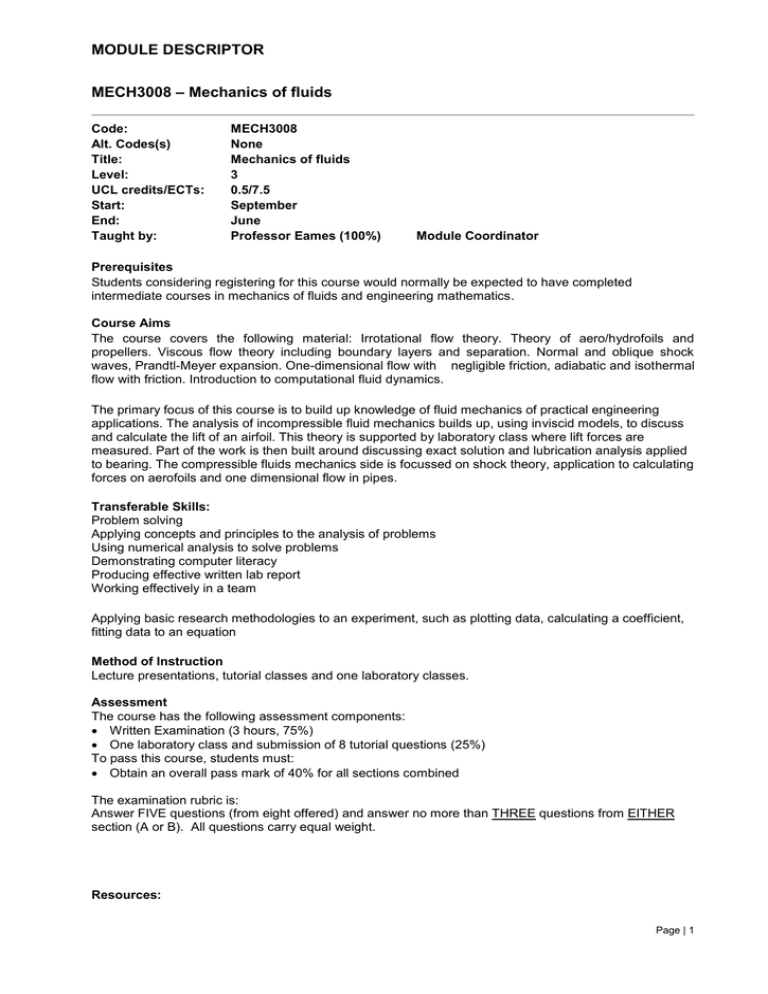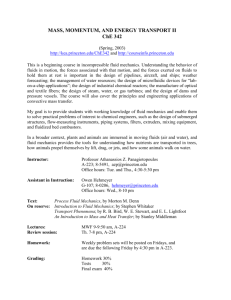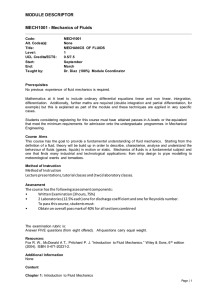MODULE DESCRIPTOR – Mechanics of fluids MECH3008
advertisement

MODULE DESCRIPTOR MECH3008 – Mechanics of fluids Code: Alt. Codes(s) Title: Level: UCL credits/ECTs: Start: End: Taught by: MECH3008 None Mechanics of fluids 3 0.5/7.5 September June Professor Eames (100%) Module Coordinator Prerequisites Students considering registering for this course would normally be expected to have completed intermediate courses in mechanics of fluids and engineering mathematics. Course Aims The course covers the following material: Irrotational flow theory. Theory of aero/hydrofoils and propellers. Viscous flow theory including boundary layers and separation. Normal and oblique shock waves, Prandtl-Meyer expansion. One-dimensional flow with negligible friction, adiabatic and isothermal flow with friction. Introduction to computational fluid dynamics. The primary focus of this course is to build up knowledge of fluid mechanics of practical engineering applications. The analysis of incompressible fluid mechanics builds up, using inviscid models, to discuss and calculate the lift of an airfoil. This theory is supported by laboratory class where lift forces are measured. Part of the work is then built around discussing exact solution and lubrication analysis applied to bearing. The compressible fluids mechanics side is focussed on shock theory, application to calculating forces on aerofoils and one dimensional flow in pipes. Transferable Skills: Problem solving Applying concepts and principles to the analysis of problems Using numerical analysis to solve problems Demonstrating computer literacy Producing effective written lab report Working effectively in a team Applying basic research methodologies to an experiment, such as plotting data, calculating a coefficient, fitting data to an equation Method of Instruction Lecture presentations, tutorial classes and one laboratory classes. Assessment The course has the following assessment components: Written Examination (3 hours, 75%) One laboratory class and submission of 8 tutorial questions (25%) To pass this course, students must: Obtain an overall pass mark of 40% for all sections combined The examination rubric is: Answer FIVE questions (from eight offered) and answer no more than THREE questions from EITHER section (A or B). All questions carry equal weight. Resources: Page | 1 Bernard Massey (revised by John Ward-Smith), Mechanics of fluids: (Stanley Thornes (Publishers) Ltd) H. Chanson The Hydraulics of Open Channel Flow (Wiley) 1999 F.M. Henderson Open Channel Flow (MacMillan) S. Goldstein (ed.) Modern developments in fluid dynamics: an account of theory and experiment relating to boundary layers, turbulent motion and wakes, Vol.1 (Dover Publications) 1965 G James, Advanced Modern Engineering Mathematics (Pearson Prentice Hall), M Boas, Mathematical Methods in the Physical Sciences (5th Edition) published by Wiley, P.V. ONeil, Advanced Engineering Mathematics (Thomson), McQuarrie, Mathematical Methods for Scientists and Engineers (University Science Books), Kreyszig, Advanced Engineering Mathematics (Harper &,,, Rowe) Additional Information None. Workload: 24 Lectures 8 Tutorials 1 laboratory class and report writing Content Lecture 1- 12 : Incompressible flow 1. Lecture 1 potential flow theory 2. Lecture 2 and potential flow theory 3. Lecture 3 solutions to the Laplaces equation in two dimensional 4. Lecture 4 solutions to the Laplaces equation in two dimensional 6. Lecture 6 Pressure distribution around a cylinder 6. Lecture 7 Pressure distribution around a cylinder 7. Lecture 8 Method of images and conformal mapping 8. Lecture 9 Method of images and conformal mapping 9. Lecture 10 Method of images and conformal mapping 10. Lecture 11 Method of images and conformal mapping 11. Lecture 12 Viscous flow analysis 12. Lecture 13 Viscous flow analysis Lecture 1- 12 : Compressible flow 1. Lecture 1 Compressible flow introduction 2. Lecture 2 Thermodynamics review and stagnation variables 3. Lecture 3 Normal shock analysis 4. Lecture 4 Oblique shock analysis 5. Lecture 5 Expansion of supersonic two-dimensional stream 6. Lecture 6 The supersonic flat plate aerofoil 7. Lecture 7 Reflection of oblique shock waves and expansion fans 8. Lecture 8 Non-isentropic one-dimensional flow in ducts 9. Lecture 9 Non-isentropic one-dimensional flow in ducts 10. Lecture 10 Operation of diverging and converging nozzles 11. Lecture 11 Operation of diverging and converging nozzles 12. Lecture 12 Operation of diverging and converging nozzles Page | 2 General Learning Outcomes Knowledge and Understanding Fluid mechanics of practical engineering applications; analysis of incompressible flow using fluid using inviscid models and its application to lift of an airfoil and lubrication analysis in bearings; compressible fluids mechanics applied shock theory - applications to aerofoils and one dimensional flow in pipes; appreciate the capabilities and limitations of computational fluid dynamics in solving common engineering problems. Skills and Attributes (i) Intellectual Governing principles of incompressible and compressible fluid mechanics, drawing on conservation principles. Use of analytical techniques (such as conformal mapping), similarity techniques and graphical methods for solution. (ii) Practical Laboratory skills in the laboratory using wind tunnels and force balances. Practical application of CFD using ACESim to examine the flow around and lift/drag forces on an aerofoil (including mesh generation and data analysis). Application of fluid mechanics to lifting surfaces, lubrication theory and compressible flows. (iii) Transferable Application of engineering science and numerical analysis to the Solution practical engineering problems; use of generic techniques to analyse fluid flow problems using other proprietary CFD packages. Page | 3




